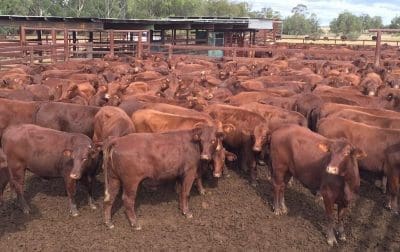AN important recent regulatory change removing the requirement for veterinary prescription to access a popular cattle vaccine will pave the way for greater protection against respiratory disease.
Previously, only veterinarians could prescribe and supply Zoetis’ Rhinogard IBR vaccine, via an S4 classification under the national Scheduled Medicines Act.

That has recently changed, with Rhinogard IBR removed from the Scheduled Medicines list and freely available to the industry through over-the-counter sales.
The single-dose intra-nasal spray vaccine protects cattle against Infectious Bovine Rhinotracheitis (IBR). The product provides rapid onset of immunity after vaccination.
In addition to the scheduling change, Rhinogard has moved from a wet-frozen vaccine format with limited shelf-life, to a freeze-dried product which is much easier to store and use.
Minimum pack size under the new freeze-dried format has gone from 500 doses to smaller 10 and 50 dose packs.
For the practical reasons, including pack-size, Rhinogard has for the past 20 years been used primarily by larger-scale commercial feedlot operators, with high cattle turnover and easy access to vets.
But easier access and changes to the formulation and pack sizes now means the protection benefits can start earlier in the production cycle.
Vets are likely to continue to supply the vaccine to feedlot clients as they always have, but smaller feedyards and the broader industry now can access and use the product more conveniently.
Resellers and merchandise outlets will now stock the product, including smaller pack-sizes, on their shelves for direct sale to producers.
The fact that Rhinogard is a single-dose product makes it easy to administer at weaning or branding, without the need for bringing cattle in a second time for re-treatment.
Background
Infectious Bovine Rhinotracheitis (IBR) is a common viral infection of cattle, damaging the animal’s airways, and increasing the risk of respiratory disease.
Australian disease surveillance shows that IBR is one of the most common viral components of the bovine respiratory disease (BRD) complex. Cattle are at risk both on-farm, and in the feedlot, with 80-90pc of cattle herds showing evidence of prior exposure.
Treatment stimulates an immune response in the animal’s upper respiratory airways, providing protection at the site where the virus enters the body.
Field studies conducted during the registration of Rhinogard showed that when given prior to field challenge, the vaccine improves average daily gains and feed conversions in cattle, compared with control animals.
Application beyond the feedyard
As beef herds get bigger and weaner management becomes more intensive in pursuit of greater productivity, more on-property vaccination for IBR is occurring.
Most cattle producers now have cattle handling facilities that allow easy nasal administration of the vaccine.
Some large producers with high cattle turnover are already routinely administering Rhinogard vaccine in the pre-feedlot stage. But it’s anticipated that the new formulation with more flexible shelf-life and a range of smaller pack-sizes will see much broader uptake among beef producers for protection of young cattle. In some cases, feeder cattle may also be sold as pre-vaccinated.
There is also growing use of Rhinogard in vaccinating bulls. Routine treatment of bulls has not happened in the past because of the previous practicalities surrounding Rhinogard pack-size (minimum 500 doses) with limited shelf-life.
The same Bovine Herpesvirus that causes IBR can also cause lesions in the reproductive tract of breeding cattle. While the Bovine Herpesvirus strains found in Australia do not cause abortions, they do cause infections in breeding females (IPV) and bulls (IBP).
Australian developed
Rhinogard vaccine was originally developed by the Queensland Department of Primary Industries following MLA’s BRD research in the 1990s. This came in response to local industry concerns over clinical outbreaks of IBR in feedlot cattle.
Some lobbied the government over importation of IBR vaccines from the US, but different strains exist in different parts of the world. Rhinogard was developed locally targeting Australian strains of IBR, produced and marketed initially by Q-Vax, later bought by Pfizer (now Zoetis).
- Many readers may not be familiar with the Rhinogard product, because its previous S4 status prohibited advertising to laymen. That has now changed. See this week’s ads on Beef Central or click this link to read more about the product, how it works, the productivity benefits, product handling and means of application.
